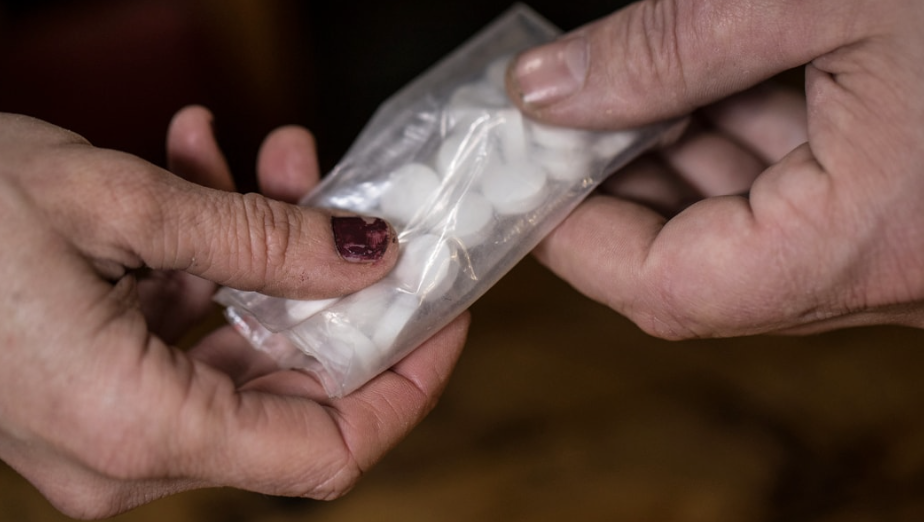Nitazene is a potent synthetic opioid known to be stronger than morphine. This article explains what nitazene is, its street names, various forms, and the severe risks, including overdose, that come with its use.
Key Takeaways
- Nitazene is a highly potent synthetic opioid, significantly stronger than fentanyl, which raises serious overdose risks.
- Common street names for nitazene include ‘Nitaz,’ ‘Nazzy,’ and ‘fake oxycodone,’ complicating identification and increasing overdose incidents.
- The drug can cause severe side effects, including respiratory depression and addiction, highlighting the need for strict medical supervision and awareness of its dangers.
What is Nitazene?
Nitazene is a synthetic opioid, belonging to the broader family of opioid analgesics — understanding what opioids are helps explain their intense potency and risk. These drugs are designed to mimic the pain-relieving properties of naturally occurring opiates like morphine, but are often much more potent. Nitazenes, in particular, are known for their high potency, which has contributed to a troubling rise in nitazene deaths and nitazene involvement in overdose cases.
These substances are not naturally occurring; they are man-made, crafted in laboratories to enhance their efficacy and potency. Due to their synthetic nature, nitazenes can be modified to create various analogs, each with slightly different chemical structures but often similar, if not more potent, effects.

Is Nitazene stronger than Fentanyl?
Yes, nitazene is considered stronger than fentanyl, which is already one of the most potent synthetic opioids involved in widespread addiction and overdose cases. Nitazenes, including n-pyrrolidino etonitazene, have been found to be significantly more potent than fentanyl, making them extremely dangerous. This increased potency means that even a small amount can have a powerful, often deadly, effect.
The strength of nitazenes compared to other opioids like morphine and heroin is staggering. For instance, some nitazene analogs are reported to be hundreds of times more potent than morphine. This high potency, combined with the ease of mixing with other drugs, makes nitazenes a particularly lethal addition to the illicit drug market.
The involvement of nitazenes in overdose deaths is a grim testament to their dangerous nature.
What is Nitazene composed of?
Nitazene is a synthetic compound, formulated from a combination of chemical ingredients designed to produce powerful opioid effects. The exact chemical formula for nitazene is C23H30N4O2, indicating it contains 23 carbon atoms, 30 hydrogen atoms, 4 nitrogen atoms, and 2 oxygen atoms. This intricate composition underscores its man-made origin, distinguishing it from naturally occurring opioids.
The precise balance of these elements results in a substance with high potency and significant potential for abuse, including methamphetamine.
What forms does Nitazene exist?
Nitazene can be found in various forms, including:
- Powder
- Capsules
- Tablets
- Syrups
Among these, the tablet form is particularly popular due to its ability to mimic medications like oxycodone, increasing the risk of oxycodone addiction when users unknowingly consume nitazene.
This versatility in form has contributed to its widespread occurrence in the drug supply, making it a significant concern for public health officials and law enforcement agencies, particularly in the context of harm reduction, as noted by the World Health Organization, and the potential for harm, which is increasingly recorded and present.
What is the Street name of Nitazene?
Nitazene is known by several street names, which can vary depending on the region and the form in which it is sold. Common street names include “Nitaz,” “Nazzy,” and “fake oxycodone,” reflecting its frequent misrepresentation as oxycodone. These street names can often obscure the true identity of the drug, leading to increased risks of accidental overdose and death.
The proliferation of nitazenes under various street names complicates efforts to control their distribution and use. These names, coupled with the drug’s potent effects, make it a significant threat in the illicit drug market. As these substances continue to infiltrate the drug supply, the risk of nitazene deaths and overdoses remains alarmingly high.
What are the types of Nitazene?
Nitazenes encompass a range of synthetic opioids, each with varying degrees of potency and risk. Notable examples include isotonitazene, metonitazene, etonitazene, and protonitazene. These substances can appear in various forms, such as white powder, crystalline solids, or tablets mimicking other drugs like oxycodone.
Each type of nitazene presents its own set of challenges for detection and regulation. The ability to exist in multiple forms increases the likelihood of these substances being misrepresented or mixed with other drugs, which are commonly detected, further complicating efforts to mitigate their impact on public health.
What does nitazene do to the human body?
Nitazene acts on the body’s opioid receptors, producing effects similar to other opioids such as pain relief, sedation, and euphoria — but with a significantly higher risk of opioid addiction. However, due to its high potency, nitazene can also cause severe respiratory depression, leading to difficulty breathing, coma, and even death.
The side effects of nitazene are extensive and can include drowsiness, nausea, confusion, and constipation. In severe cases, nitazene use can result in respiratory arrest and fatal overdose. The high risk associated with nitazene highlights the importance of understanding its effects and the dangers it poses to users.
Is nitazene addictive in nature?
Yes, nitazene is highly addictive due to its potent effects on the brain’s opioid receptors. Like other opioids, nitazene can lead to physical dependence and addiction, characterized by the compulsive use of the drug despite negative consequences. This addictive nature is exacerbated by the drug’s high potency, making it difficult for users to control their intake.
The addictiveness of nitazene is comparable to other substances such as heroin and methadone, making it especially difficult to quit once use begins. Users often experience intense cravings and withdrawal symptoms, which can drive continued use and increase the risk of overdose. The involvement of nitazene in multiple substance abuse cases further underscores its addictive potential.
What is the optimal dosage of nitazene for medical use?
The optimal dosage of nitazene for medical use is carefully controlled to minimize the risk of adverse effects. In a clinical setting, nitazene is used in much lower doses than those found in the illicit market. The right dose depends on the patient’s condition and response to the treatment, making it essential to administer nitazene under strict medical supervision.
What is the lethal dose of nitazene in humans?
The lethal dose of nitazene varies depending on several factors, including the individual’s tolerance and overall health. However, it is generally considered to be extremely low, with even small amounts posing a significant risk of fatal overdose. Nitazene’s high potency means that doses as small as a few milligrams can be lethal, underscoring the importance of careful dosing and monitoring.
What is nitazene overdose?
A nitazene overdose occurs when an individual consumes a dose of nitazene that overwhelms the body’s ability to process the drug safely. Symptoms of overdose include:
- Severe respiratory depression
- Extreme drowsiness
- Confusion
- Loss of consciousness
The risk of overdose is heightened when nitazene is mixed with other substances such as alcohol or benzodiazepines, leading to an increased risk.
Immediate medical intervention is crucial to address the symptoms and prevent fatal outcomes, especially when emergency services are needed.
How strong is nitazene?
Nitazene is one of the most potent synthetic opioids available, with some analogs reported to be over 100 times stronger than morphine. This high potency makes nitazene an extremely dangerous opioid, even in small amounts. The strength of different types of nitazene varies, but all are significantly more potent than many other opioids.
Symptoms of nitazene overdose include severe respiratory depression, pinpoint pupils, and loss of consciousness. The high potency and risk of overdose make nitazene a significant threat to public health, necessitating increased awareness and caution among users and healthcare providers alike.
Bottom Line: What is Nitazene
In summary, nitazenes represent a highly potent class of synthetic opioids that pose significant risks to users. Their high potency, combined with the potential for addiction and overdose, makes them a critical concern in the ongoing opioid crisis. Understanding what nitazenes are, their street names, types, and effects on the human body is essential for mitigating their impact.
As we continue to grapple with the challenges posed by nitazenes, it is crucial to promote awareness and education about these dangerous substances. By staying informed and vigilant, we can work towards reducing the harm caused by nitazenes and protecting public health.
FAQs about Nitazene
What is nitazene?
Nitazene is a potent synthetic opioid linked to an increase in overdose cases. Its high potency raises significant concerns regarding safety and potential misuse.
How does nitazene compare to fentanyl in terms of strength?
Nitazene is stronger than fentanyl, categorizing it among the most potent synthetic opioids. This heightened strength poses significant risks for overdose and misuse.
What are the street names for nitazene?
Nitazene is often referred to on the street as "Nitaz," "Nazzy," or "Fake Oxy." These names highlight its similarities to more well-known opioids.
What are the different types of nitazene?
The different types of nitazene include isotonitazene, metonitazene, etonitazene, and protonitazene. Understanding these variations is crucial for recognizing their potential effects and risks.
What are the symptoms of a nitazene overdose?
A nitazene overdose can lead to severe respiratory depression, extreme drowsiness, confusion, and loss of consciousness. Immediate medical attention is crucial in such cases.
















